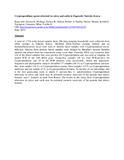Cryptosporidium species detected in calves and cattle in Dagoretti, Nairobi, Kenya

View/
Date
2012Author
Kang’ethe, Erastus K
Mulinge, Erastus K
Skilton, Robert A
Njahira, Moses
Monda, Joseph G
Nyongesa, Concepta
Mbae, Cecilia K
Type
ArticleLanguage
enMetadata
Show full item recordAbstract
A total of 1,734 cattle faecal samples from 296 dairy-keeping households were collected from urban settings in Nairobi, Kenya. Modified Ziehl–Neelsen staining method
and an immunofluorescence assay were used to identify those samples with Cryptosporidium oocyst infection. Oocysts from positive faecal samples were isolated by Sheather's sucrose flotation method and picked from the concentrate using cover
slips. Genomic DNA was extracted from 124 of the faecal samples that were positive for Cryptosporidium and was used as template for nested PCR of the 18S rRNA gene. Twentyfive samples (20 %) were PCR-positive for Cryptosporidium, and 24 of the PCR products were successfully cloned and sequenced. Sequence and phylogenetic analysis identified 17 samples (68 %) as Cryptosporidium parvum-like, four samples
(16 %) as Cryptosporidium ryanae, three samples (12 %) as Cryptosporidium andersoni and one sample (4 %) as Cryptosporidium hominis. To the best of our knowledge, this is the first genotyping study to report C. parvum-like, C. andersonishow Cryptosporidium infections in calves and cattle may be potential zoonotic reservoirs of the parasite that infects humans. and C. hominis in cattle from Kenya. The results of this study show Cryptosporidium infections in calves and cattle may be potential zoonotic reservoirs of the parasite that infects humans.
Citation
Trop Anim Health Prod (2012) 44 (Suppl 1):S25–S31Publisher
Department of Public Health, Pharmacology and Toxicology, Faculty of Veterinary Medicine Centre for Microbiology Research, Bioscience eastern and central Africa-International Livestock Research Institute Hub (BecA-ILRI Hub),Nairobi, Kenya
